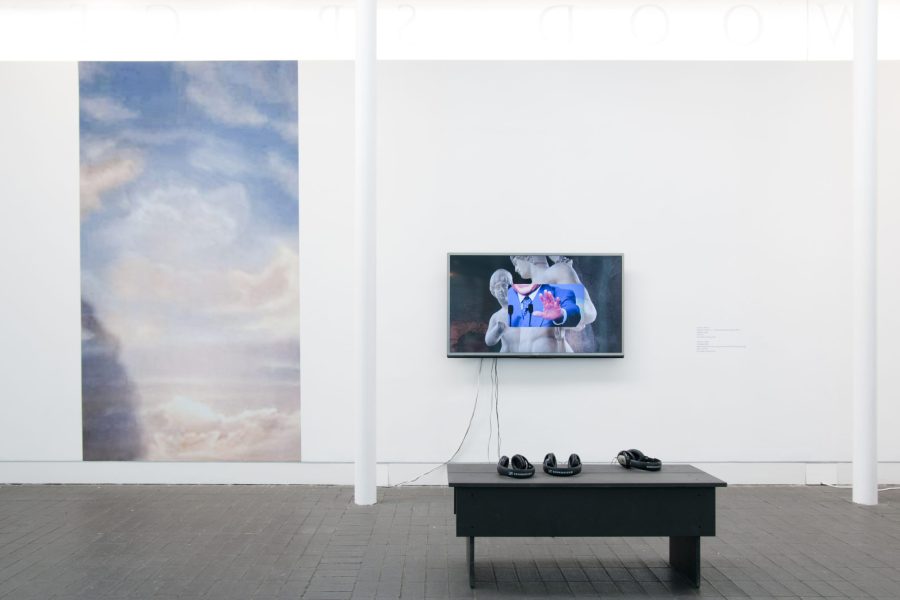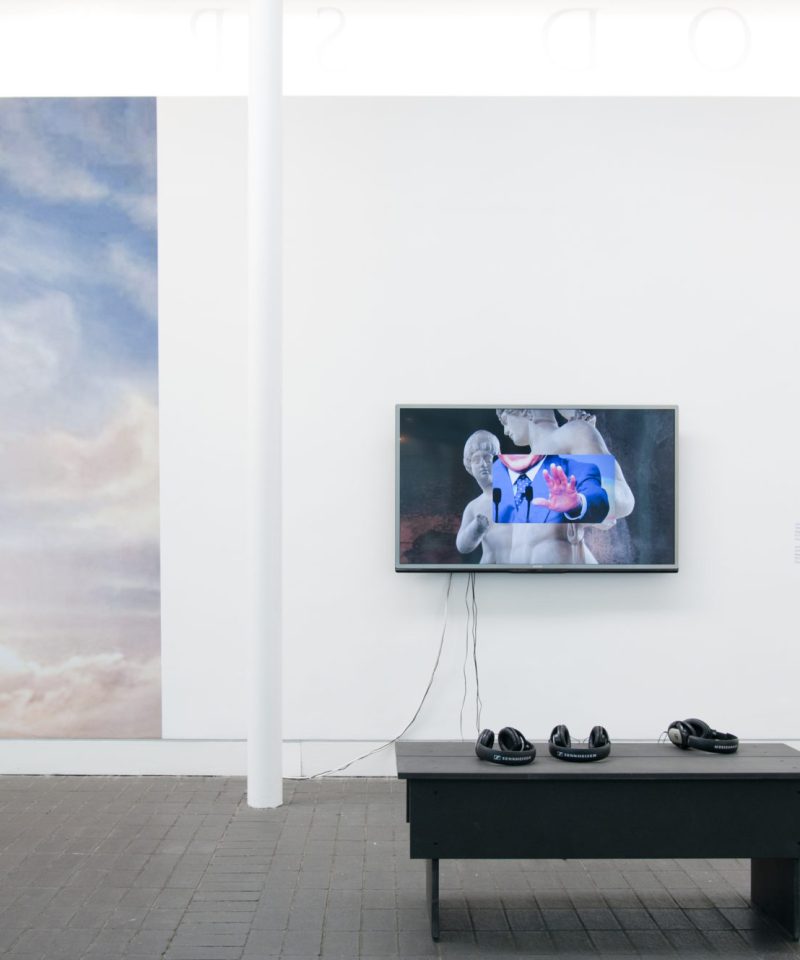I met up to talk to Heather Phillipson whose work Zero-Point Garbage Matte (2012) featured in the exhibition TTTT at Jerwood Space to ask her about her practice.
Where to start? As I said in my email I feel there are a lot of questions I don’t know how to ask about yet, before we start a conversation.
I liked it when you said you didn’t know how to ask your questions. I often feel like I don’t know how to ask something until it’s underway – especially with making – and then it’s too late and you’re midway through a conversation you didn’t anticipate.
I think I meant that there are threads that run through all your works and I don’t know whether to start with those, or with one work in particular …
I think it’s good to start with something specific, but either one of those approaches could be specific – a specific thread, or a specific work – working through the links. It’s something that I find challenging myself, and sometimes generative too – what are the specificities? How can I articulate them? It’s something you’re often required to do as an artist – to put a frame around your practice, to put names on bits of it – to translate it into words, to tie it down in some way. And, actually, on any given day, I feel I could speak about my practice differently – there are forking paths all over it. Maybe you could say that for all practices to some extent, but it’s definitely something I’m aware of with my own work. I could talk about it in terms of video, say, or music, rhythm, collage, language, the voice, the body, sculpture, architecture, physical and digital navigation of space, colour, line-breaks, metaphors… and that’s just the obvious, concrete stuff. And I have talked about it in relation to all of these things, which is sometimes the useful aspect of framing – having the opportunity to re-confront the practice, or to transpose it, or to change my mind, or to locate it differently. So that element of not knowing what something is, or where to start, or re-asking it what it’s doing, is the same for me – and that’s actually a big part of what I’m addressing.
Zero-Point Garbage Matte from Heather Phillipson on Vimeo.
Can you tell me about your decision to put most of your videos online?
There are different reasons. Probably the clearest one is that the internet’s a context to which the work is referring and, moreover, using. I take material from the internet, so by re-locating the videos there it feels that there’s an exchange – the videos return to (one of the) place(s) that birthed them. But the videos also take from and refer to multiple other real and imagined places, so why not push them back out into the world in multiple forms and places too? Maybe this also relates to the question of framing – I’m preoccupied by the possibilities of context, and what might be added, or lost, by, say, watching the video at home on your laptop as opposed to inside a highly controlled gallery installation. Maybe a small screen and crappy speakers is not, for me, the optimum experience of the work, but I’m interested that it can be an experience of the work and certainly a very different one. I think of it as the work having separate but related lives.
It’s a bit like the difference between the performance of poetry and reading it in a book, in a way, two such different formats.
That’s a good comparison. Maybe it has something to do with live-ness? There’s the intimate relationship that you might have with something when you’re reading it in a book or watching it on a laptop, when it’s just you and the thing – being ‘alone’ together. And then there’s the experience of encountering it in a space where you have to engage with it physically, and with other people too. I think both involve a kind of ‘live-ness’, a mix of private and public in different proportions, but that ‘live-ness’ is qualitatively different .
A poetry reading has an obvious public live-ness, but there can be a brilliant intimacy to it too. The potency of just a body speaking in space, to other bodies – there’s something really physically intense about that. Speaking about it now, it imakes me think of when I saw Robert Ashley read live, with no musical accompaniment – it was mind-blowingly intense, and long too – and that seemed to the be the point, the drifting in and out – that it becomes about something else – not understanding necessarily, but the flow between the ‘notes’. In contemporary poetry, there’s a tendency to opt for brevity in readings, in order to hold attention – almost like an acknowledgment that you can’t take in that level of intensity (and intimacy) and really attend to it at the same time. Whereas artists often work with that intensity, and rhythms of distraction, in a different way – pushing it.
I’d imagine you’d need to be brief if you want people to pay attention to the construction of a sentence, for example.
Yes, if you want people to hear what’s been packed into it… poetry’s so dense – you’re not really meant to ‘get it’ on a single hearing, or maybe not even on several hearings (or readings). Because it’s so dense you need space around it and, later, repetition. You need space around the words because they need to resonate in your head. And then you need to re-encounter them. Perhaps that’s like the different versions of the video installations too – what happens, or changes, with repeated exposure.
One of the hallmarks of your work is there isn’t enough time to reflect – you’re immersed in this barrage, almost, not barrage but a seamless flow of words … and you’re looking down, your body’s forming part of something that’s outside of you.
I think it goes back to this issue of multiplicity, and some idea of stuffing or snapping time, treating it spatially – making available different routes or perspectives or moments. Almost simultaneously, for example, you might become hyper-conscious of your body in relation to the video, and in the (public) space, and then a bit of music will kick in, or stop, and you’ll notice something beside you, and then the rhythm changes, and that might pull you into the video. But, again, all this is something you can come back to – there’s probably no desire, on either part, to give it all away, or to have it all given away.



Do you edit your videos to a score?
No, I edit relatively spontaneously, like composing, which is how I write as well – it’s really about rhythm. It all happens in the editing, in that process of banging things together, trying to find the electricity.
Do you think about an audience?
Not really – at least, not when I’m inside the making. Bonnie Camplin once said to me that she thinks about art as a ‘private epistemological adventure’. I love this expression. It’s about going on an adventure with the material. Once the work’s made it finds its audience and I don’t really mind who that audience is. It doesn’t need to be for everyone, but it can be for anyone.
Is there anything you’d like to talk about in your work that doesn’t get spoken about?
People often ask about the structure of the videos – how words are used, or music, or collage or sculpture, but one thing that’s important, that doesn’t come up that much, is emotion – love, terror, anger, joy. Maybe it’s not that fashionable to talk about emotion in relation to art – that thing we can’t control, and then try to.
Somebody asked me recently why I like irony so much. This threw me a little, the assumption that I’m aiming for irony because, for me, it’s not irony – my work isn’t ironic. In that way, at least, it’s really quite straightforward – despairing or celebratory, resolute or terrified, or all of them at once… But I found it interesting that the work was being interpreted like that. Maybe because it holds what appear to be conflicting positions simultaneously…
Maybe because the humour is quite deadpan.
Yes, maybe because the tone isn’t easily read, it resembles irony? It doesn’t for me, but I see how the tonal shifts are confusing – how one tone comes to a sudden halt, and just as you’re getting into the fun, it becomes anxiety – it flips. But, for what it’s worth, the emotions are what they are. Often the starting points for the videos are things that I feel deeply troubled by, or ecstatic about. The work frequently begins with an emotion. Or mixed emotions. So it’s less about irony and more about contrariness and complexity, not knowing whether to be in love with the world or to smash its face in – the difficulty of sustaining.
I felt that from the Splashy Phasings (2013), that it was really moving, even though it was just 3 minutes long, like a commercial.
I’m glad. Superficially, you wouldn’t necessarily read it that way – there’s a veneer of absurdity, which is comedic…but then the tragedy is rammed in, or is riding along beneath it all along, or floods in when it stops.
Splashy Phasings from Heather Phillipson on Vimeo.



